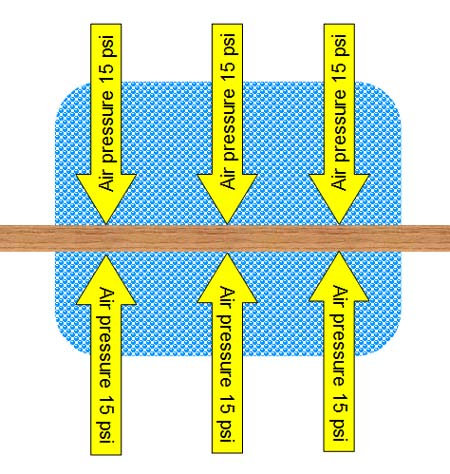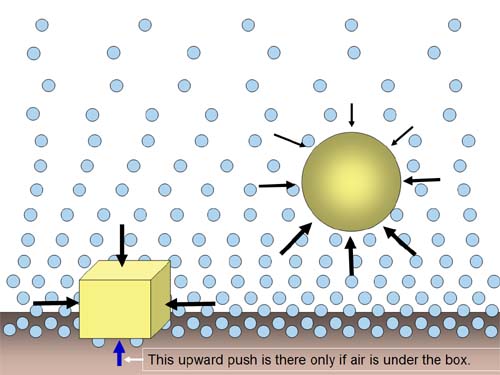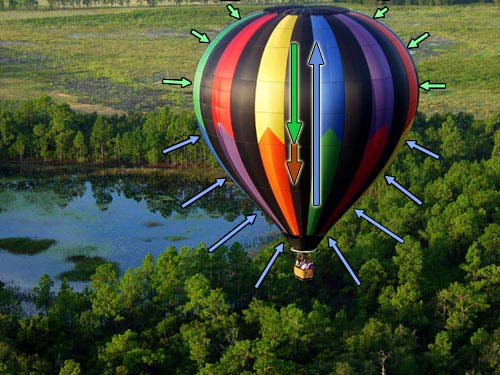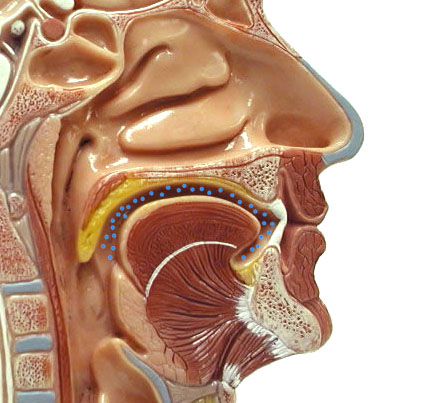|
|
Before you can understand air pollution, you need to
have an understanding of air. One way to begin learning about air is to
clear up the misconceptions of air.
|
|
Misconception
#1: There's a lot of air
|
|

|
|
To us the atmosphere seems very thick, but compared to
the Earth, it is only a thin skin of gas (red circle). Seeing how thin it should help
us realize how easily it could be filled with pollutants.
Besides giving us the oxygen we need to breathe, it also
sheilds us from harmful ultraviolet radiation and small meteors. The atmosphere
also helps hold in the warmth of the sun and spreads the warmth more evenly
over the Earth's surface. It also carries water from the oceans
to the land by way of clouds and rain.
|
|
Misconception #2: Air
is light weight
|
|
|
Misconception #2: Air is light weight.
We don't feel the weight of air nor do balloons seem heavy.
It is true that for the same volume, air is lighter than liquid
or solids. But there are many miles of air above us pushing down
with incredible weight.
|
|
|
| Air is so heavy that it can lift this Jet.
Even when the jet is sitting on the ground, the air underneath the jet is
lifting with several thousand pounds of force. However, the air on top of
the jet and on top of the wings is pushing it down with practically the
same thousands of pounds of force. |
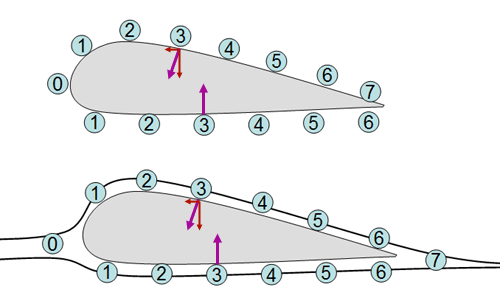 |
This is how the plane can fly. The top
drawing shows the wing not moving in the air. Because the top of the wing
is curved, there is more surface area and more air hitting it. The 7 balls
represent the number of air molecules hitting it. Underneath the wing
there are only 6. The top 7 don't push down more than the bottom 6 because
the 7 are hitting at an angle which decreases their downward push. For
example, the top #3 molecule has the same force (pressure) as the bottom
#3, but the top #3 hits at an angle reducing it's downward force.
But when the wing is moving, the air splits
at 0 and rejoins at 7. So the top doesn't have 7 hitting it anymore, just
6. The six on the top of the curved wing hit at angles which reduces their
downward force. The 6 under the wing hit the wing with a push that goes
straight up. So the bottom 6 out-push the top 6 and the plane is lifted
up.
|
|
|
Air gets heavier as it cools. For example,
sometimes rain falling in a thundercloud cools the air fast and the heavy
air comes crashing downward. The dropping speed is usually about 45 miles
per hour but can reach 200 miles per hour endangering planes, people, and
property. This is called a microburst. |
|
|
Normally the air gets cooler as we go higher,
but sometimes the air near the ground is colder than the air above it. Because
cold air is heavier, it will stay close to the ground. This traps pollutants.
This condition is common in Phoenix in the winter and results in the infamous
brown cloud. |
|
Misconception #3: Suction
|
|
Suction
Cups
|
|
|
The way suction cups work is usually very much
misunderstood. Contrary to popular believe, suction is not
what holds suction cups to the surface. |
|
|
Before a suction cup even attaches to a surface,
there is air pressure pushing on the surface at about 15 pounds per square. |
|
|
When the suction cup touches the surface, air
is still between the suction cup and the surface (e.g., table top or window).
Air underneath the suction cup presses in all directions, which includes
pushing up at 15 psi. The suction cup can easily
be pulled away at this point. |
|
|
However, if the suction cup is pressed all the way down
to expel all of the air, there is no longer any pressure pushing upward
on the suction cup and the outside air pressure is now pressing down on
the suction cup. This is what holds the suction cup in place.
So there is no sticking or
attraction force that makes the suction cup stick to the surface. It is
held there by air pressure. It just seems
that the suction cup has some unseen stickiness holding it there.
|
|
|
Note: In a similar fashion, any time air gets
squeezed out from between two objects, they will be held together by air
pressure. For example, if you've ever walked through mud, you noticed how
hard it is to lift your feet. That's not because mud is sticky or thick.
It's because air gets squeezed out from between your shoes and the mud.
Air pressure will try to hold your feet and shoes down. |
|
|
Sometimes suction cups are used for lifting or pulling.
Let's say the surface is that of a table. When a person pulls on the middle
of a suction cup, they have to overcome the pressure of the 80 miles of
air above the suction cup, which is 15 pounds per square inch. When they
do, the suction cup lifts a little creating a vacuum gap. A vacuum is
nothing, so it has no force. So it no longer pushes down on the surface.
However, underneath that surface, air pressure is still pushing up at
15 psi, so it will lift the table (provided the table doesn't weigh too
much). For example, if the vacuum gap covers 3 square inches, then 3 square
inches under the table will push with 45 lbs (3x15 psi.) To lift a heavier
table, you need a bigger suction cup that can make a vacuum gap with a
bigger area.
|
|
Drinking through a Straw
|
|
|
Even though babies know how
to drink from a straw, most people, young or old, don't
know how it works. Most people think the suction caused by our mouth pulls
the liquid up through the straw. |
|
|
One clue to understanding this is to notice what happens
to the cheeks of people drinking through a straw. This is especially noticeable
if the drink is thick like a shake. You see that their cheeks are pushed
in.
This is caused by the air pressure outside their cheeks
being higher than the air pressure in their mouth.
|
|
|
Normally when your mouth is closed, there's
not much air (blue spheres) inside your mouth. They bounce around causing
15 psi pressure in the mouth. However, when you drop your jaw and keep your
lips closed, there's more room for the air to spread out (Roll mouse over
image to see this). The air molecules are now spread out over a larger volume,
so fewer are now striking each square inch of the inside of the mouth; so
the air pressure inside the mouth is less (perhaps about 10 psi). Outside
air at 15 psi is trying to get into the mouth. It pushes on the cheeks causing
them to be sunken. |
|
|
If you have a straw in your mouth, then air
pressure pushing on your drink has more force
than the force from the air in your mouth. The outside air pressure pushes
onto the surface of the drink. This pressure pushes
liquid up through the straw to your mouth. When you don't want to drink
anymore, you will move your jaw upwards causing
the air in the mouth to be more crowded, which increases the air pressure
in the mouth to equal that of the outside air pressure. The liquid will
stop flowing. |
|
Misconception #4: Calm
Air
|
|
|
Since air is invisible it's easy to think of it just being
still because we've heard the phrases, "calm air" and "the
air was still". However, even when air is not blowing, it is far
from being still.
|
|
|
In a helium balloon, the helium atoms are travelling an
average of 3,000 miles per hour! In air, the oxygen and nitrogen molecules*
are travelling about 1,000 miles per hour! At these incredibles speeds,
one atom will collide with other atoms and objects near them 7 billion
times a second!
(*Note: Oxygen atoms travel in pairs as does nitrogen
atoms. Two or more atoms combined is called molecules. So we say a gas
of oxygen molecules and nitrogen molecules rather than saying oxygen atoms
and nitrogen atoms)
|
|
|
|
|
This means that if a small air
leak develops in the vacuum of space, air molecules rush out over a 1,000
miles per hour. There is no atmosphere to hold back the leak. |
|
Misconceptions #4 & 5: Air
is uniform & Hot Air Rises
|
|
|
Air is invisibile, so when we
look at things through the air, we normally think the air is uniform. If
that were true, this balloon would not float. |
|
|
The air around us is being compressed
by all of the air above us. The closer the air is to the ground the more
weight is on it, and the more compressed (or dense) it is. That means
the air at the top of an object is not as dense as the air under objects.
In fact the air around us is constantly trying to lift everything because
the air below objects press a bit harder than the air above the object.
|
|
|
In this picture, I replaced some
of the balloons with bowling balls to make the point that air is pushing
up on bowling balls or helium filled balloons the same amount. (as long
as they are the same size). Again, that's because the air under a bowling
ball or balloon is more dense (compressed) than the air near the top of
the bowling ball or balloon. |
|
|
The balloon rises because the
air pushing on the bottom of the balloon has a greater force than the downward
force of the air on top of the balloon plus the balloon's own weight. In
the case of the bowling ball, the red weight arrow is so large, the upward
lift from the bottom air goes unnoticed. |
|
|
So the real reason hot air balloons float,
is NOT "Hot Air Rises." It's because the air pressing on the lower
half of the balloon is greater than the combined air pressing on the upper
half and the weight of the balloon. All the hot air does is to reduce the
weight of the air in the balloon. Hot air is more spread out than cool air,
so it's lighter. When the burner is on the air inside is heated and as it
expands much of it goes out the bottom of the balloon. This reduces the
red arrow, which represents the total weight of the balloon. |








